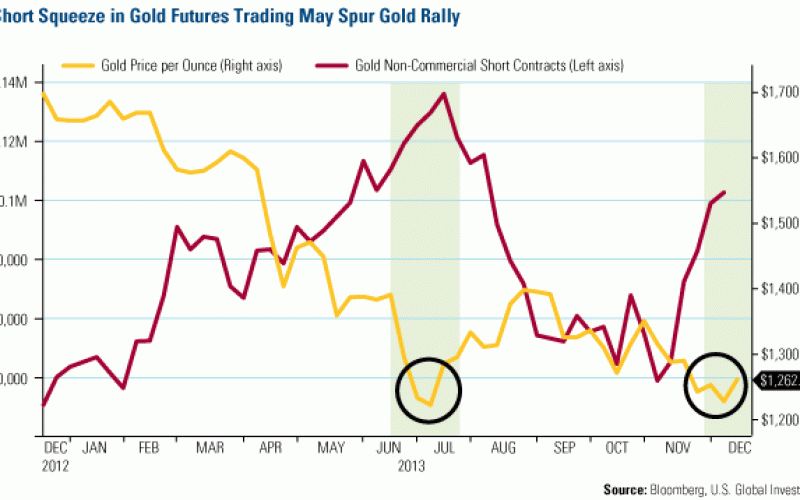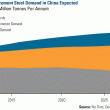Gold Market Radar (December 16, 2013)
For the week, spot gold closed at $1,238.26, up $9.21 per ounce, or 0.75 percent. Gold stocks, as measured by the NYSE Arca Gold Miners Index, rose 2.05 percent. The U.S. Trade-Weighted Dollar Index lost 0.15 percent for the week.
Strengths
- The dollar will no longer be among the best performing currencies in 2014, according to Thomas Stolper, Goldman Sachs’ Chief Currency Strategist. Stolper, who correctly predicted this year’s dollar weakness against the euro, is challenging the strong consensus built around a stronger dollar next year. According to Stolper the dollar will continue to weaken, as any Federal Reserve tapering will be offset by interest rates being kept at about zero. In addition, Stolper is of the opinion that tapering is already priced in, and there seems to be no other source of dollar strength in sight. The dollar strength talk and expectation of higher interest rates has weighed heavily on gold and commodity prices throughout 2013, and a reversal in consensus will likely result in gold strength.
- The implementation of the Volcker Rule over the next two years is likely to reduce big banks’ dealings in gold and silver for their own speculative purposes. The Rule prohibits banks with federally-insured deposits from trading activities undertaken for their own benefit, such as proprietary trading. According to a recent Mineweb article, the Rule should, in theory, prohibit banks such as JP Morgan and Goldman Sachs from trading in gold forwards, futures and options contracts, except on behalf of customers. Once the law is in full effect, gold and silver fundamentals should take a greater role in price determination, as speculative trades are reduced.
- Another intermediate producer is entering West Africa where merger and acquisition (M&A) activity is picking up. Centamin is making an all-share offer, off market for Ampella. The offer is valued at A$41MM, representing a 113 percent premium to the close on December 9. Ampella has a 1.7 gram per tonne, 3.2 million ounce deposit on the Batie West greenstone belt in Cote D’Ivoire. This marks the second transaction we have seen in West Africa in the past six weeks. This week Franco Nevada signed a new streaming deal with Teranga Gold, which will receive $135 million in exchange for 22,500 ounces of gold per year during the first six years, and 6 percent of production thereafter. Teranga Gold surged 31 percent on the news.
Weaknesses
- Gold prices fell mid-week as congressional negotiators reached a U.S. budget agreement. There had been lingering concerns over whether legislators would reach a budget agreement before having to shutdown government next January as the funding deadline approached. The approved budget will not reverse the growing U.S. fiscal deficit, but it has been interpreted as one less obstacle before the Federal Reserve can go ahead with its quantitative easing tapering program.
- BCA Research published a note in which it attempted to forecast gold price action based on historical averages, suggesting gold may trade down to the $1,000 level based on historical production premium, and to $660 when using the median, real-adjusted price since the Bretton-Woods era. The flaw with this type of reasoning is that gold cannot be valued in the context of commodities. The market has ruled that gold is a financial instrument as evidenced by gold trading historically with a contango, just like S&P 500 futures do. In other words, gold prices are not mean-reverting as are oil and copper, which typically trade in backwardation with forward prices converging towards an average. It is for that same reason that nobody forecasts future prices for the S&P 500 by using its long-term average.
- Iamgold’s CEO Steve Letwin announced the company will be suspending its dividend payments until further notice, as current gold prices demand the company preserves its balance sheet. For the past five quarters the company has produced a negative free cash flow of $132 million per quarter. The dividend suspension, together with cost cutting measures implemented earlier this year, is expected to save the company just under $200 million per year. Following a recent visit to Lakeshore Gold’s Bell Creek operations, BMO analysts are of the opinion that despite the positive operational improvements made recently, it appears unlikely that Lakeshore will be able to pay down its debt load without restructuring. At current spot prices, neither the company’s credit facility with Sprott, nor the convertible debentures, can be repaid without external financing, concluded the note.
Opportunities
- Gold rose strongly earlier in the week in what appeared to be a short-squeeze motivated rally. Gold rebounded from the $1,200 level and reached its highest level since mid-November. As seen in the chart above, open short positions as reported by the Commodity Futures Trading Commission rose back above the 0.1 million level, which was the level that led to a rebound off the $1,200 level in June. As BMO analysts report, that summer rebound off the $1,200 level led to a 40 percent rally in the GDM Index.
- The Wall Street Journal published an article saying China’s reforms may boost gold investments in the country. Beijing pledged after its Third Plenum last month to give the market a more decisive role in a number of sectors, which could lead to policies that make it easier for investors to access gold investments. The implications are substantial. Despite China becoming the largest gold consumer this year, the per capita consumption is 4.5 grams, compared with a 24-gram global average. The low consumption level and the increase in investment demand for gold from the Asian nation will likely result in stronger global demand.
- Gold premiums continue to soar in India as the nation moves into wedding season. Gold importers are demanding record premiums for the scarce metal. Premiums reached $180 per ounce over London prices for immediate delivery, as jewelers argue there is no gold available anywhere in the country following a severe slowdown in the recycled gold trade. About 300,000 jewelers and bullion dealers are demanding the government ease import rules on gold with many jewelers being forced to shut down shop. The hope for change appears in the form of Narendra Modi, the main opposition party’s candidate for next year’s general election. Mr. Modi is not only a staunch Hinduist, where rites and ceremonies are abundant, he is also the head of India’s most prolific Gujarat province, where he has led economic growth of 10 percent per year over the last decade on a platform of eliminating red tape, and limiting government interference with private enterprise.
Threats
- David Rosenberg of Gluskin Sheff continues to argue that signals of imminent inflation can not be ignored any longer. Wage inflation will be the next driver as fast-food workers across the country are demanding $15 hourly wages, arguing that profit margins among public companies are at a record 11.1 percent, nearly doubling the historical average of 6 percent. But this is not the only inflationary pressure, according to Rosenberg. The current supply and demand dynamics of the labor market are reaching a boiling point. Rosenberg illustrates that the pool of labor supply is narrowing mostly due to a structural change in demographics. On the other hand, demand for labor continues to increase, and the laws of supply and demand are such that these curves dictate wage inflation is coming in the next few months.
- Fred Hickey, writer of The High-Tech Strategist, brings some market data that may have you rethinking your portfolio allocation strategy. For starters, the Investors Intelligence Sentiment survey reports that only 14.4 percent of respondents are bearish on the market; a level only seen leading into the 1987 crash. In addition, investors are pouring money into equity mutual funds at the fastest pace since the peak of 2000. Furthermore, the Shiller price-to-earnings (P/E) ratio for the S&P 500 is now over 25, a level seen only three times in the past; 1929, 2000 and 2007. Do you see the pattern? His conclusion is that fear has simply left the building. However, fear is exactly what investors should be feeling since a rise of interest rates to “normal” would destroy the housing market, and 27 percent of auto loans are subprime and back to 2007 levels. The cherry pick is the fact that the notional value of global derivatives is no longer in the trillions of dollars, as it was just before the 2007 crisis when Warren Buffet described them as weapons of mass destruction, but has rather soared into the uncharted territory of $1 quadrillion.
- Joy Global, the Milwaukee-based heavy equipment manufacturer, announced its fourth-quarter net income plunged 87 percent as customers sought to stretch their building plans and delayed regular maintenance. The weaker market conditions are a result of the weakness in gold and commodity prices, the correction has lasted longer than anticipated, leading to a 62 percent decrease in equipment orders from last year. The resulting impact on cash flows for most of Joy’s customers mean that, even with a commodity rebound next year, the headwinds in terms of customers’ orders will continue well into 2014 as miners seek to stabilize their balance sheets before commissioning any new project development.
















